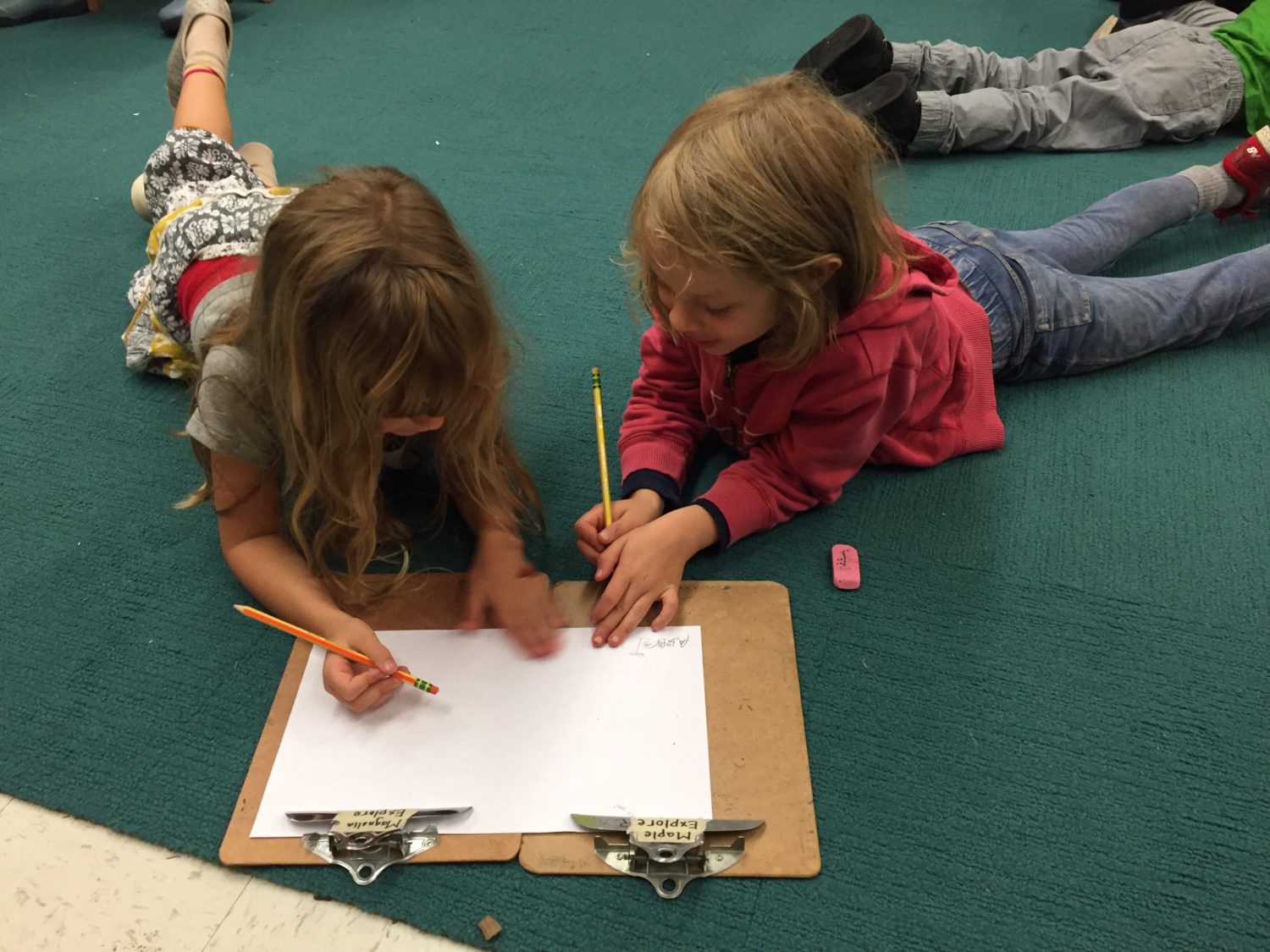Coming soon to Office Depot

At this week’s Opal School staff meeting, we continued our research into invention education (see earlier posts here and here). We decided to start considering the inventions children might create into three big buckets:
- Systems (Amy brought up all the games children invent as part of PE)
- Art and other expressive ideas (our blog and publications are full of these, I think) and
- Technology and tools
Sarah brought forward this image that I think suggests what we might begin to see in that third bucket. The children had been working with large sheets of paper to record their thinking – but the clipboards available fit smaller sheets. They wanted to work on the carpet rather than at a table or on the tiled floor. A & S each grabbed a clipboard – and linked them together to form one large enough to carry the sheet.
When I think about this small story, it seems to fit the elements we’ve begun to describe in earlier posts: the conditions led the children to identify a problem they cared about for which no completely satisfactory tools were present. Their way of solving the problem was novel: as far as I know, no one is selling modular connecting clipboards – but I won’t be surprised to find a rack of them at an office supply store soon.
But is it useful to others? Thus far, their strategy hasn’t caught on in the classroom. I wonder whether it will. If this “invention” is brought to the group, will they start using it? Might the group start tracking the inventions their community is producing? Could naming this lead to new discoveries and innovations?
I wonder:
What are the children you work with inventing?
What conditions seem to support those inventions?
Want to read more about invention? Here are a few of the texts we’re paying attention to:
- Inventology: How We Dream Up Things That Change the World by Pagan Kennedy
- The Creative Spark: How Imagination Made Humans Exceptional by Agustín Fuentes
- Invention: Enhancing inventiveness for quality of life, competitiveness, and sustainability (Report of the Committee for Study of Invention)

Thanks for sharing links to additional readings!
The question, “what conditions seem to support those inventions?” is one I’ve been grappling with a lot lately. One one hand, I believe there are always opportunities to create and invent with the problems we bump into naturally throughout the day, and yet, when I’m planning the classroom environment, I wonder what decisions I’m making that are supporting opportunities for problem-solving and/or invention? An example that comes to mind when wondering how to support invention is our message center where many of the children love to cut all the paper into tiny pieces. It’s become a bit of a knot for me, as I’m concerned about our resources and wondering how other children who want to draw feel about not having paper. Upon further observation, the children who were cutting and cutting explained they were making “pieces” for their monster which they intended to glue together on a large paper. They were essentially creating their own collage materials. I am curious about where this might take our work, and how I can remain open to the possibilities of materials in the classroom while supporting their ideas, as well as the rest of the community.
As I read the three blog posts on invention education, “something” kept popping up in my mind: dialogue! In your posts, and in the classrooms when I get to observe, I see children in dialogue with themselves, with each other, with the materials, with the environment; I see teachers in dialogue with children, with colleagues, with ideas, etc. But this dialogue does not happen randomly – there are elements/ingredients that I noticed Opal students and teachers practicing over and over. I know I don’t have an exhaustive list, nor am I going to mention them in any meaningful order, but here are some I noticed:
*being present (both in body and mind)
*listening (suspending judgement, seeking to understand)
*finding meaningful topics
*having a protocol
*seeing dialogue as a team game where all get heard and seen and all voices matter
*not anticipating the end result, and learning to love the process, the journey, the idea ball toss. Focusing not on who’s idea is it but enjoying the building of ideas together.
*helping children see themselves as writers, makers, inventors, helpers – helping them see they have something important to contribute.
*appreciating different perspectives and seeing our biases.
*being able to listen to ourselves
Reading your inspiring posts makes me wonder how do we make dialogue an integral part of our lives? How would this help us overcome isolation, fragmentation, separation? How do we as parents of Opal children enter in this dialogue (first with ourselves) and then with each other, the school and the children? What value would this bring to each of us, to the children, to the school? How could we overcome all the logistic obstacles like lack of time and busy-ness and where do we start the practice? How do we as parents contribute to invention education and what do we notice and support on a daily basis?